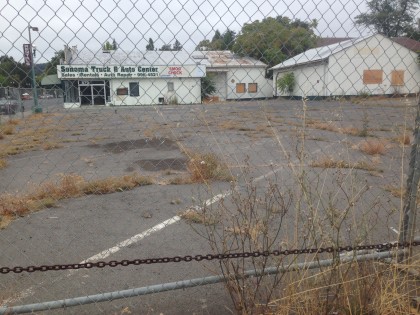Land use projects in Sonoma are always subject to CEQA, California’s Environmental Quality Act. This does not mean every project is required to undergo an extensive and expensive process of environmental evaluation, but it does mean every land use project needs to be declared either subject to the act, or exempt from it. Accordingly, CEQA has enormous influence on land use patterns, and how projects are allowed or not allowed to proceed.
The requirements of CEQA have prompted, and continue to prompt, litigation. Ongoing examples in Sonoma include the Cheese Factory demolition and reconstruction proposal of 2018 (currently under appeal) and the Gateway project at Broadway and MacArthur (now in litigation).
CEQA was created during the wave of increased environmental consciousness in the late 1960s, and was signed into law by Republican Governor Ronald Reagan in 1970. Similar to federal law, CEQA requires that each proposed project be considered individually to avoid detrimental environmental impacts. Specifically, CEQA is intended to:
- Inform decision-makers and the public about a project’s environmental impacts
- Identify ways to mitigate, avoid, or prevent environmental damage
- To inform the public as to why a project receives approval even if it leads to environmental damage
- To encourage and stimulate public participation
The first step in the process is an evaluation by the city Planning Department of whether or not CEQA applies to a given project. This often leads to an “Initial Study” of the likely environmental impacts. If those impacts are deemed significant, an Environmental Impact Report (EIR) is ordered to be prepared. An EIR lays out the specifics of any anticipated environmental damage, and establishes methods to mitigate it. Both the Initial Study and EIR are public documents and form the core of public discussion.
CEQA is not optional, which is to say government is required to evaluate all land use projects according to CEQA rules (which today run to well over 200 pages). The state legislature has modified CEQA requirements over the years, including the creation of various exemptions, particularly in regards to infill housing and second units (Accessory Dwelling Units, ADUs) in urban areas.
Because it can essentially make or break a project, the CEQA process has prompted, and continues to prompt, litigation. Citizens use CEQA to slow down the development approval process; it remains one of the primary means of insuring compliance with its environmental protections. Developers often object to CEQA constraints. They argue that mandated changes in their plans are financially burdensome, upping costs and forcing expensive delays.
The CEQA process
Approval of a discretionary land use action that involves altering the environment is considered a “project” under CEQA. This applies to government actions as well as those proposed by the private sector. (A discretionary action is different than a ministerial action; ministerial actions, like issuing a building permit or approving a sign for a business, are not subject to CEQA except in very special situations.)
Other exemptions from the requirements of CEQA have been created by the legislature, and some are categorical, such as building projects under 10,000 square feet, three or fewer homes in an urban area, transfer of land for park creation, and the newest exemptions for infill housing projects up to five acres in urban areas of at least 100,000 people.
One area of contention is what is called the “fair argument.” This issue arises when experts on opposing sides of the question of whether CEQA applies to a project disagree. Recent court decisions have sided with the opinion that if a “fair argument” is legitimately raised during the project review, then an EIR must be conducted. This fair argument issue has been raised in recent projects in Sonoma, namely the aforementioned Cheese Factory proposal, and the Gateway project.
If an action is deemed a “project” under CEQA, then an Initial Study is ordered. The purpose of the Initial Study is to determine if the environmental impacts of a project are likely to be “significant.” The issue of significance is quite subjective, and no absolute definition exists. It is the opinion of local government. Accordingly, matters of traffic, tree removals, effects on surface water, and so forth are judgement calls and subject to dispute.
If a project is found to have no significant impacts, then government prepares what’s termed a “negative declaration” indicating that no further environmental review is required. Sometimes, a “mitigated negative declaration” is issued, which incorporates mitigations (and supporting evidence) into the determination that no EIR is required.
When an EIR is required as a result of the Initial Study, it begins with a Scoping Session. During such a meeting, opinions are gathered from relevant agencies and/or the public to gain input about what the EIR should consider. This helps to determine what the EIR will include and, accordingly, has an impact of the cost of its preparation. Depending upon its scope, an EIR can cost hundreds of thousands of dollars and take up to a year to prepare.
An EIR must include detailed discussion of environmental impacts, irreversible environmental damage, project alternatives, cumulative impacts when combined with other projects, impacts on growth, and all mitigation measures. Third party specialists are often engaged to provide detailed impact analysis.
For example, the EIR for the proposed hotel on West Napa Street is currently undergoing revisions (agreed to by the developer) to expand its discussion of project alternatives (housing) and greenhouse gas-generation calculations.
Once a Draft EIR is released publicly, it is circulated and subject to written comment. A public hearing to review the Draft EIR also takes place. Both the written comments and oral testimony are gathered, and the EIR consultants must respond in writing to them. These comments and responses are then incorporated into the Final EIR, which is presented at a public meeting for certification by the Planning Commission or, if appealed, the City Council.
EIR certification can be denied if there is a discovery that significant, legal grounds exist to deny a project, but generally an EIR results in an approved project with required mitigations to reduce its environmental impacts. Sometimes, however, the conclusions of an EIR can be set aside as a matter of “overriding considerations,” such as social or economic benefit.
So, while an EIR is intended to address environmental impacts, its conclusions are not an absolute mandate, and the final determination of a controversial project often is made in the courts.






Thank you for a factual review of the basics of the California Environmental Quality Act. It is the cornerstone of environmental policy in California. It helps ensure that new development more climate-smart, healthy and environmentally sound. Good development gets approved, and poor development often gets improved. It is important to uphold this essential environmental law for the next generation and beyond.
Given the inexorable and well-documented environmental degradation caused by the relentless and accelerating growth of the human population and its activities, there is no such thing as ‘good development’ or ‘sustainable growth.’